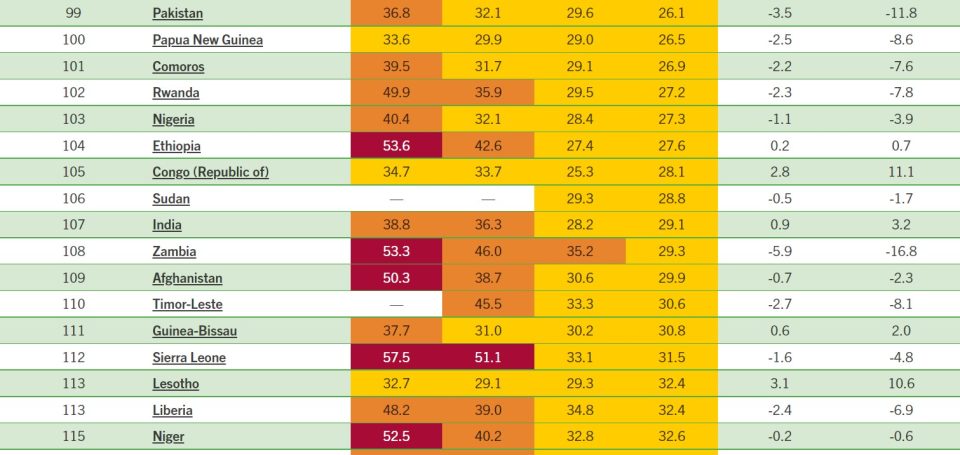
India’s poor GHI score: What is Global Hunger Index and how is it calculated?

India has ranked 107th among 121 countries on the Global Hunger Index (GHI) 2022. India’s score of 29.1, which has placed it below all South Asian countries barring Afghanistan, depicts a serious level of hunger or malnutrition. Its performance has dropped six positions from the previous GHI report. So, what is the Global Hunger Index and how is it calculated? Let us find out.
Who calculates the GHI?
Two international NGOs, Concern Worldwide and Welthungerlife, jointly publish the GHI. They have been publishing the GHI almost every year since 2000. This year’s report is the 15th one.
The NGOs use several data—including reports by the UN’s Food and Agriculture Organization (FAO), World Health Organization (WHO), UNICEF, World Bank, and the UN Inter-Agency Group for Child Mortality Estimation (IGME)—to score the nations by their severity of hunger.
Also read: India at 101/116 in Global Hunger Index; method flawed, says Smriti Irani
How is GHI calculated?
The GHI maps hunger from four indicators:
1. Prevalence of undernourishment (FAO 2022 data [three-year average]): Depicted by the share of the population with insufficient caloric intake, this parameter reflects inadequate food availability.
2. Child wasting (WHO, UNICEF, and World Bank data): Calculated by the share of children under the age of five who have low weight for their height, this parameter reflects acute undernutrition.
3. Child stunting (WHO, UNICEF, and World Bank data): Calculated by the share of children under the age of five who have low height for their age, this parameter also reflects chronic undernutrition.
4. Child Mortality (UN IGME 2021): Calculated by the mortality rate of children under the age of five, this parameter reflects both inadequate nutrition and unhealthy environment.
The standardized scores for each country are aggregated to calculate the GHI score for each country. The scores are then categorized into five slots. A score of less than or equal to 9.9 means low hunger severity (a high rank). A score of 10 to 19.9 implies moderate hunger.
Also read: India slumps from 94th spot to 101 in Global Hunger Index; behind Pak, B’desh
Countries that score between 20 and 34.9 have serious hunger (India scored 29.1 and is placed in this category). A score between 35 and 49.9 means an alarming level of hunger. Anything above 50 is extremely alarming. So, a low score means a higher ranking and better performance.
Among the countries that have ranked the highest (score <5) on the GHI are China, Kuwait, Chile, Belarus, Croatia, and Hungary, among many others. India’s neighbours Sri Lanka (13.6), Myanmar (15.6), Nepal (19.1), and Bangladesh (19.6), are placed in the second category (moderate). Pakistan (26.1) is placed in the same category (serious) as India but has ranked higher (99).
Among the worst performers are the African nations of Chad, The Democratic Republic of Congo, Madagascar, Central African Republic, and Yemen (alarming). The good news is that none of the countries reported an extremely alarming level of hunger.
India’s record
If you are disappointed by India’s dismal performance, take heart from the fact that the nation has improved its scores from 38.8 (“alarming” category) in 2000 and 36.3 (still “alarming”) in 2007 to what it is now.
Also read: Over 9 crore Indians at risk of hunger due to climate change: Report
The figure went down to 28.2 (“serious”) in 2014. However, it seems India has not been able to improve things since then and has only gone a few notches down to score 29.1 in 2022. Its 2021 score had prompted the Centre to reject the report and call the system flawed. India’s neighbours, however, have been consistently improving their performances.
Why map hunger?
So, what is the objective behind ranking countries on hunger? The reason is to ensure that the world achieves “Zero Hunger by 2030,” which is one of the UN’s Sustainable Development Goals (SDGs). You may wonder why rich countries, such as the US, the UK, France, or Germany, do not figure on the list. The answer is that it would be a redundant exercise.
If you think “hunger” implies food deprivation here, you are wrong. It rather implies a lack of adequate food or nutritious food and is calculated based on the level of calorie intake. The four key parameters, taken together, capture these deficiencies.
The good news is that seven countries—most of them war-torn—with “extremely alarming” scores in 2000 have all improved their performances to squeeze into the “alarming” or “serious” categories. These nations included Angola, Ethiopia, Zambia, Afghanistan, Sierra Leone, Niger, and Chad. Sierra Leone had been in the “extremely alarming” category even in 2007—the only nation to be so.

